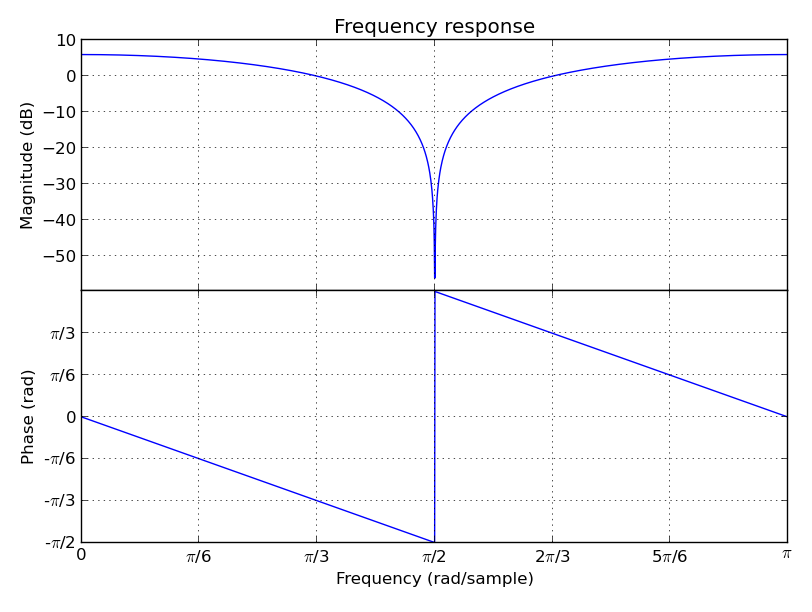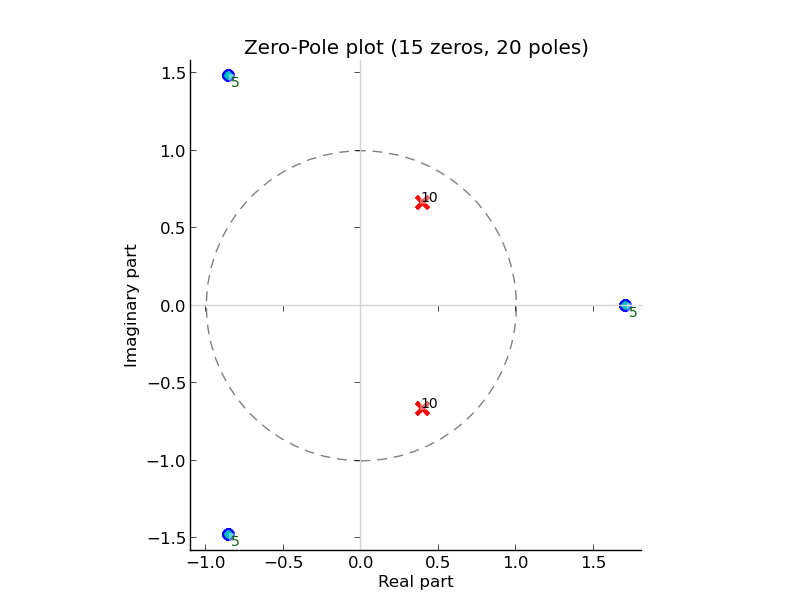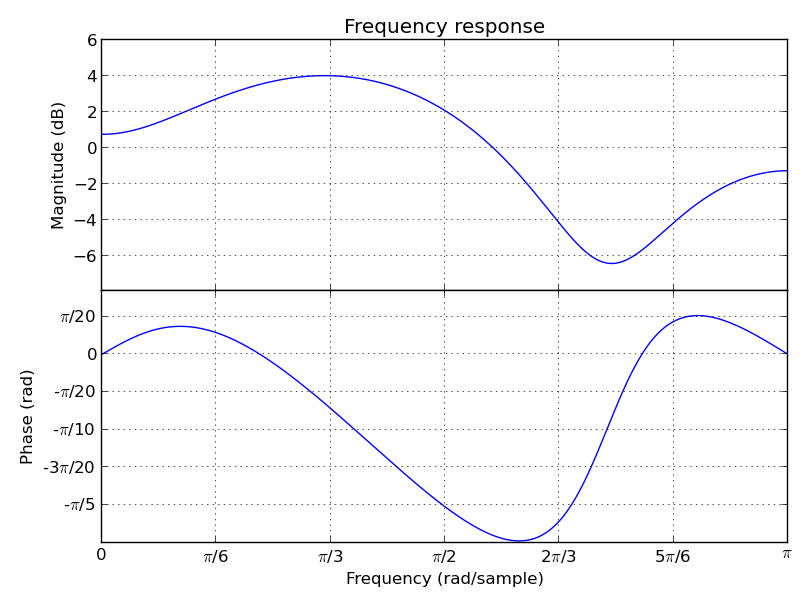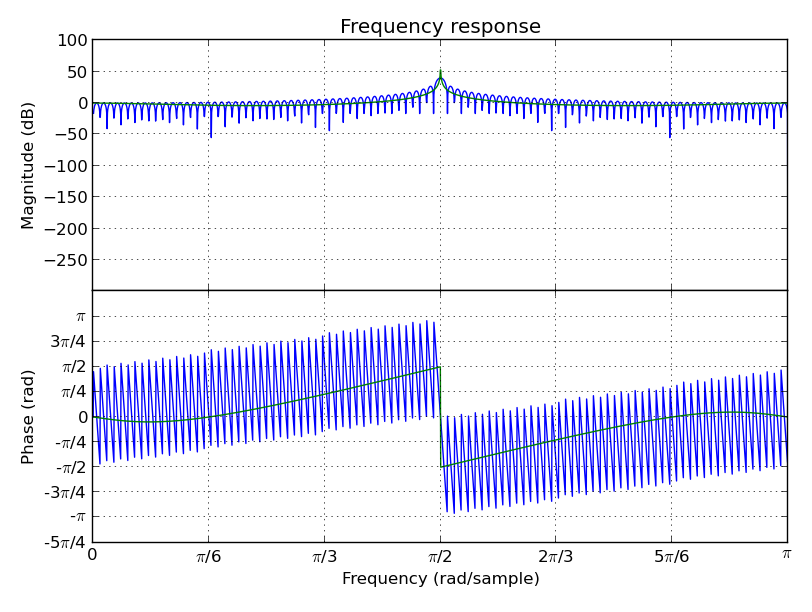| Development |   |
| Last release |    |
| PyPI status |    |
Real-Time Expressive Digital Signal Processing (DSP) Package for Python!
There are several tools and packages that let the Python use and expressiveness look like languages such as MatLab and Octave. However, the eager evaluation done by most of these tools make it difficult, perhaps impossible, to use them for real time audio processing. To avoid such eagerness, one can make the calculations only when data is requested, not when the path to the data is given. This is the core idea in laziness that allows:
- Real-time application (you don't need to wait until all data is processed to have a result);
- Endless data sequence representation;
- Data-flow representation;
- Task elimination when a reverse task is done: instead of doing something to then undo, nothing needs to be done, and no conscious optimization need to be done for that.
Another difficulty concerns expressive code creation for audio processing in blocks through indexes and vectors. Sometimes, that's unavoidable, or at least such avoidance would limit the power of the system that works with sequence data.
Block sequences can be found from sample sequences being both objects, where the latter can be the result of a method or function over the former. The information needed for such is the block size and where would start the next block. Although one can think about the last block and the exact index where it would start, most of the time spent in steps like this one happens to be an implementation issue that just keep the focus away from the problem being worked on. To allow a thing like an endless data sequence, there should be no need to know when something stops.
Probably an engineer would find the use of equations and structures from electrical engineering theory much cleaner to understand than storing everything into data arrays, mainly when common operations are done to these representations. What is the product of the filter with numerator [1, 7, 2] and denominator [1, 0.5, 0.2] as its system equation with the one that has the arrays reversed like [2, 7, 1]? That might be simple, and the reversed would avoid questions like "what comes first, the zero or the [minus] two exponent?", but maybe we could get more efficient ourselves if we had something easier: multiplication could be written once and for all and with a representation programmers are used to see. This would be even more expressive if we could get rid from the asymmetry of a method call like filt1.multiply_by(filt2), since multiplication in this case should be commutative. The use of natural operators is possible in a language that allows operator overloading, but for such we need to describe those equations and structures as objects and object relationships.
The name Hz can be a number that would allow conversion to a default DSP internal rad/samples unit, so one can write things like freq = 440 * Hz. This isn't difficult in probably any language, but can help in expressiveness, already. If (almost) everything would need data in "samples" or "rad/sample" units, constants for converting these from "second" and "hertz" would help with the code expressiveness. A comb filter comb.tau(delay=30*s, tau=40*s) can represent a comb filter with the given delay and time constant, both in samples, but with a more clear meaning for the reader than it would have with an expression like [1] + [0] * 239999 + [alpha]. Would it be needed to store all those zeros while just using the filter to get a frequency response plot?
It's possible to avoid some of these problems with well-chosen constants, duck typing, overloaded operators, functions as first-class citizens, object oriented together with functional style programming, etc.., resources that the Python language gives us for free.
Prioritizing code expressiveness, clarity and simplicity, without precluding the lazy evaluation, and aiming to be used together with Numpy, Scipy and Matplotlib as well as default Python structures like lists and generators, AudioLazy is a package written in pure Python proposing digital audio signal processing (DSP), featuring:
- A
Streamclass for finite and endless signals representation with elementwise operators (auto-broadcast with non-iterables) in a common Python iterable container accepting heterogeneous data; - Strongly sample-based representation (Stream class) with easy conversion to block representation using the
Stream.blocks(size, hop)method; - Sample-based interactive processing with
ControlStream; Streamixmixer for iterables given their starting time deltas;- Multi-thread audio I/O integration with PyAudio;
- Linear filtering with Z-transform filters directly as equations (e.g.
filt = 1 / (1 - .3 * z ** -1)), including linear time variant filters (i.e., theaina * z ** kcan be a Stream instance), cascade filters (behaves as a list of filters), resonators, etc.. EachLinearFilterinstance is compiled just in time when called; - Zeros and poles plots and frequency response plotting integration with MatPlotLib;
- Linear Predictive Coding (LPC) directly to
ZFilterinstances, from which you can find PARCOR coeffs and LSFs; - Both sample-based (e.g., zero-cross rate, envelope, moving average, clipping, unwrapping) and block-based (e.g., window functions, DFT, autocorrelation, lag matrix) analysis and processing tools;
- A simple synthesizer (Table lookup, Karplus-Strong) with processing tools (Linear ADSR envelope, fade in/out, fixed duration line stream) and basic wave data generation (sinusoid, white noise, impulse);
- Biological auditory periphery modeling (ERB and gammatone filter models);
- Multiple implementation organization as
StrategyDictinstances: callable dictionaries that allows the same name to have several different implementations (e.g.erb,gammatone,lowpass,resonator,lpc,window); - Converters among MIDI pitch numbers, strings like "F#4" and frequencies;
- Polynomials, Stream-based functions from itertools, math, cmath, and more! Go try yourself! =)
The package works both on Linux and on Windows. You can find the last stable version at PyPI and install it with the usual Python installing mechanism:
python setup.py installIf you have pip, you can go directly (use -U for update or reinstall):
pip install audiolazyfor downloading (from PyPI) and installing the package for you, or:
pip install -U .To install from a path that has the setup.py file and the package data uncompressed previously.
For the bleeding-edge version, you can install directly from the github repository (requires git for cloning):
pip install -U git+git://github.com/danilobellini/audiolazy.gitFor older versions, you can install from the PyPI link or directly from the github repository, based on the repository tags. For example, to install the version 0.04 (requires git for cloning):
pip install -U git+git://github.com/danilobellini/audiolazy.git@v0.04The package doesn't have any strong dependency for its core besides the Python itself (versions 2.7, 3.2 or newer) as well as its standard library, but you might need:
- PyAudio: needed for playing and recording audio (
AudioIOclass); - NumPy: needed for doing some maths, such as finding the LSFs from a filter or roots from a polynomial;
- MatPlotLib: needed for all default plotting, like in
LinearFilter.plotmethod and several examples; - SciPy (testing and examples only): used as an oracle for LTI filter testing and for the Butterworth filter example;
- Sympy (testing only): used for testing linear filters with time-varying matrices of symbolic coeffs where the Stream samples are these matrices;
- tox for testing all at once, or pytest, pytest-cov and pytest-timeout for testing in a single environment (testing only): runs test suite and shows code coverage status;
- wxPython (example only): used by one example with FM synthesis in an interactive GUI;
- Tkinter (example only): needed for the pitch follower based on the zero-crossing rate example GUI;
- Music21 (example only): there's one example that gets the Bach chorals from that package corpora for synthesizing and playing;
- Sphinx (documentation only): it can create the software documentation in several different file formats.
Beside examples and tests, only the filter plotting with plot and zplot methods needs MatPlotLib. Also, the routines that needs NumPy up to now are:
- Root finding with
zerosandpolesproperties (filter classes) or withrootsproperty (Poly class); - Some Linear Predictive Coding (
lpc) strategies:nautocor,autocorandcovar; - Line Spectral Frequencies
lsfandlsf_stablefunctions.
Before all examples below, it's easier to get everything from audiolazy namespace:
All modules starts with "lazy_", but their data is already loaded in the main namespace. These two lines of code do the same thing:
Endless iterables with operators (be careful with loops through an endless iterator!):
And also finite iterators (you can think on any Stream as a generator with elementwise operators):
LTI Filtering from system equations (Z-transform). After this, try summing, composing, multiplying ZFilter objects:
>>> filt = 1 - z ** -1 # Diff between a sample and the previous one
>>> filt
1 - z^-1
>>> data = filt([.1, .2, .4, .3, .2, -.1, -.3, -.2]) # Past memory has 0.0
>>> data # This should have internally [.1, .1, .2, -.1, -.1, -.3, -.2, .1]
<audiolazy.lazy_stream.Stream object at ...>
>>> data *= 10 # Elementwise gain
>>> [int(round(x)) for x in data] # Streams are iterables
[1, 1, 2, -1, -1, -3, -2, 1]
>>> data_int = filt([1, 2, 4, 3, 2, -1, -3, -2], zero=0) # Now zero is int
>>> list(data_int)
[1, 1, 2, -1, -1, -3, -2, 1]LTI Filter frequency response plot (needs MatPlotLib):
The matplotlib.figure.Figure.show method won't work unless you're using a newer version of MatPlotLib (works on MatPlotLib 1.2.0), but you still can save the above plot directly to a PDF, PNG, etc. with older versions (e.g. MatPlotLib 1.0.1):
On the other hand, you can always show the figure using MatPlotLib directly:
CascadeFilter instances and ParallelFilter instances are lists of filters with the same operator behavior as a list, and also works for plotting linear filters. Constructors accepts both a filter and an iterable with filters. For example, a zeros and poles plot (needs MatPlotLib):
Linear Predictive Coding (LPC) autocorrelation method analysis filter frequency response plot (needs MatPlotLib):
Linear Predictive Coding covariance method analysis and synthesis filter, followed by the frequency response plot together with block data DFT (MatPlotLib):
>>> data = Stream(-1., 0., 1., 0.) # Periodic
>>> blk = data.take(200)
>>> analysis_filt = lpc.covar(blk, 4)
>>> analysis_filt
1 + 0.5 * z^-2 - 0.5 * z^-4
>>> residual = list(analysis_filt(blk))
>>> residual[:10]
[-1.0, 0.0, 0.5, 0.0, 0.0, 0.0, 0.0, 0.0, 0.0, 0.0]
>>> synth_filt = 1 / analysis_filt
>>> synth_filt(residual).take(10)
[-1.0, 0.0, 1.0, 0.0, -1.0, 0.0, 1.0, 0.0, -1.0, 0.0]
>>> amplified_blk = list(Stream(blk) * -200) # For alignment w/ DFT
>>> synth_filt.plot(blk=amplified_blk).show()AudioLazy doesn't need any audio card to process audio, but needs PyAudio to play some sound:
rate = 44100 # Sampling rate, in samples/second
s, Hz = sHz(rate) # Seconds and hertz
ms = 1e-3 * s
note1 = karplus_strong(440 * Hz) # Pluck "digitar" synth
note2 = zeros(300 * ms).append(karplus_strong(880 * Hz))
notes = (note1 + note2) * .5
sound = notes.take(int(2 * s)) # 2 seconds of a Karplus-Strong note
with AudioIO(True) as player: # True means "wait for all sounds to stop"
player.play(sound, rate=rate)See also the docstrings and the "examples" directory at the github repository for more help. Also, the huge test suite might help you understanding how the package works and how to use it.
There are several files and directories in the AudioLazy repository (as well as in the source distribution):
| File/Directory | Description |
|---|---|
| audiolazy/ | AudioLazy package modules source code |
| audiolazy/tests/ | Testing subpackage |
| docs/ | Documentation generation scripts |
| examples/ | Examples for some AudioLazy use cases |
| images/ | Images referenced by some reStructuredText documentation file |
| math/ | Proof for some formula used by AudioLazy using Sympy CAS |
| CHANGES.rst | AudioLazy History, a.k.a. change log |
conftest.py |
Configuration for py.test, to work properly with doctests on StrategyDict strategies and on an environment missing Numpy |
| COPYING.txt | License file |
MANIFEST.in |
List of extra distributed files to be included in the tarball that doesn't need to be installed together with the package |
| README.rst | Some general information about the AudioLazy project |
| setup.py | General Python setup script for installation, testing, etc. |
| tox.ini | Configuration for tox, py.test and pytest-cov |
.travis.yml |
Travis-CI configuration (not in PyPI tarball/"egg" source distribution) |
The examples and the math directories might be useful for an AudioLazy user. All Python files in these two directories are scripts intended to run on both Python 2 and 3 unless they need something not yet available for Python 3 (e.g. wxPython), most of them have some external dependency.
Copyright (C) 2012-2016 Danilo de Jesus da Silva Bellini
License is GPLv3. See COPYING.txt for more details.



